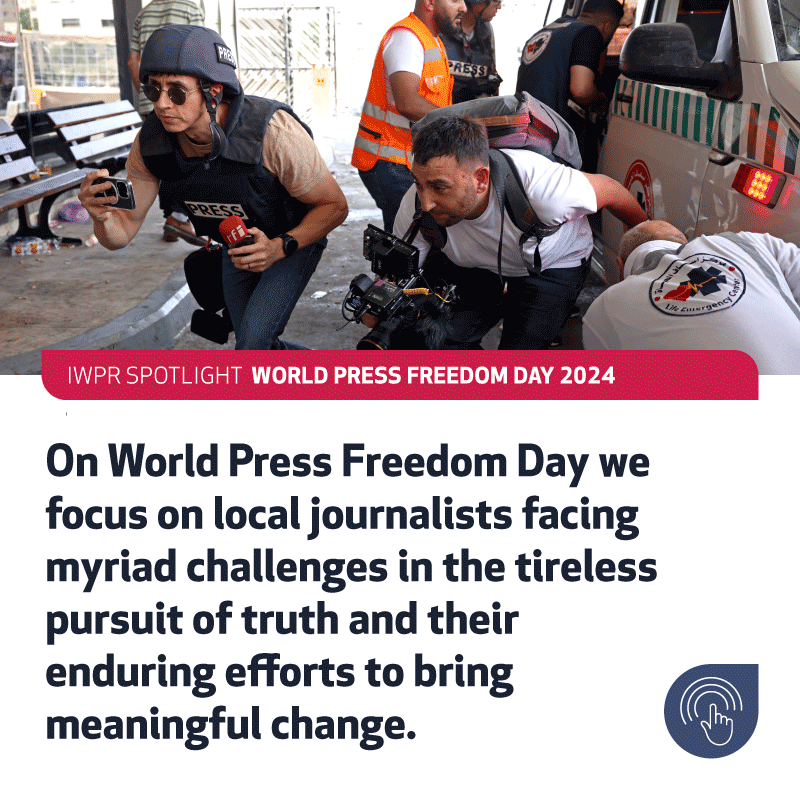Press Freedom Struggles in Kenya
Cases of harassment have mounted amid a surge in police brutality as well as overt government antagonism.
Kenyan journalists are warning of escalating tensions and violence amid rising threats to press freedom in the wake of President William Ruto's August 2022 election.
Last year, Kenya fell from a ranking of 69 out of 180 in the annual Reporters Without Borders press freedom index to 116. Cases of harassment have mounted amid a surge in hostility, characterised by police brutality against journalists during public demonstrations, as well as overt antagonism from the government.
Shifts in Kenya's advertising directives have also sparked an outcry.
Most recently, the government announced in March that all its entities would channel advertisements solely through the state-run Kenya Broadcasting Corporation (KBC) – just weeks after it awarded exclusive publication rights to The Star newspaper, which critics argued threatened media diversity and independence.
“It’s our plea to the government to protect the media.”
“This directive is a deliberate attempt to stifle dissenting voices, control the public narrative, and ultimately weaken the democratic fabric of the nation,” The Kenya Media Sector Working Group announced in a statement. “A healthy democracy thrives on a plurality of ideas and viewpoints, not on a singular, government-sanctioned narrative.”
The move follows a troubling year in which a series of protests spurred by opposition leader Raila Odinga's rallying cry against the soaring cost of living and purported vote manipulation saw journalists assailed by law enforcement and demonstrators alike.
March 2023 was dubbed “the darkest month for Kenyan media” by the Media Council of Kenya. No fewer than 25 reporters suffered attacks from both rioters and the police. Among them was NTV's Eric Isinta, who sustained burns and fractured jaw after he was struck by a tear gas canister.
"While covering the demonstration March 30 in Nairobi, I was on top of a vehicle then the teargas was thrown towards us, that's the moment I knew we were to die,” the videographer told IWPR. “I remember police officers who were tasked to protect us hitting me with teargas that took me down.
“While on the ground, I was blacked out but could see a police water cannon approaching me with general police officers coming to finish me thinking that I was a protester. It was this time that my fellow journalists shouted to them that I was a journalist despite having a bulletproof [vest] that indicated to them that I was a journalist.”
“Professional journalists should never be attacked while doing our work.”
Samson Wire, a photographer with The Standard Media Group, described how he had also been injured during a rally.
"I vividly remember, it was on a protest day between the opposition and the government on the high cost of living within one of the slum areas in Nairobi,” he continued. “Protesters were in a scuffle with police officers, police throwing tear gas and water cannons while the protesters were throwing stones. That's when I was hit on the left side of my face by a stone; my head has never been the same again.”
In January, journalists again found themselves under attack while covering a raid by the National Authority for the Campaign against Alcohol and Drug Abuse (NACADA) over shisha smoking, banned in Kenya since 2017.
The Friday night raid on the Kettle House Bar and Grill in Nairobi turned violent when bouncers lashed out at the media personnel.
Jane Kibira, a journalist from the Kenya Broadcasting Corporation, recalled arriving at the club at around 11pm together with other reporters and half-a-dozen ploce officers.
“We gained access smoothly but in five minutes after entering the premises the club bouncers started becoming violent on all of us,” she continued. “I was stabbed on the back, beaten with slaps that tore my eardrum which am still nursing to date. I almost lost my hearing.”
Nation Media photographer Boniface Bogita was also stabbed, while Standard Media Group photographers Boniface Okendo and Jackson Kibet were physically assaulted and their cameras destroyed.
Okendo told IWPR that the police had failed to protect them from the bouncers.
“We as the media passed through a lot from police brutality, attack from the members of the public whose interests we serve, hooligans and other state agencies,” he continued. “It’s our plea to the government to protect the media. They should prosecute those who lay attacks on the media.”
The Kenya Union of Journalists (KUJ) and NACADA condemned the attacks, urging swift action to bring the perpetrators to justice. So far 18 suspects have been arrested.
“The case is still at the plea stage at the courts, but we hope justice will be served,” Kibira said. “It might not be today or tomorrow, but someday am sure it will happen, and also the assaulters will learn a lesson for the safety of journalist's tomorrow.”
The Media Council of Kenya has called for thorough investigations into all violations.
"We lack the institutional structures to protect the journalists doing their stories,” said its CEO David Omwoyo. “We can seriously expose the journalists and their safety and [that] of their families can get compromised.”
Isinta, who said he was still traumatised by his experience in March 2023, said that the media needed to organise to ensure their common safety.
“My recommendation [is for] all the media to have a joint production to protect all the journalists involved,” he continued. “Let us have accountability by having proper safety gear and proper medical care and compensation in instances of injury.”
“Professional journalists should never be attacked while doing our work,” Kibira said. “We are not thugs and we have media ethics and guidelines that guide us everyday as we deliver our societal mandates of being the watchdog.”
This publication was produced as part of IWPR’s Voices for Change, Africa project.

